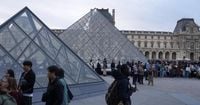In the heart of Paris, beneath the storied glass pyramid of the Louvre, a crime unfolded on October 19, 2025, that has left France—and the global art world—reeling. In a matter of just seven minutes, masked thieves executed a jewel heist so daring and meticulously planned that it has sent shockwaves through the country’s political, cultural, and security establishments. The loss: eight or nine priceless pieces from the French crown jewels collection, valued at approximately $100 million, including the crown of Empress Eugénie, encrusted with 1,354 diamonds and 56 emeralds.
The operation itself seemed almost cinematic. According to The Week and France Inter, the thieves arrived in a truck equipped with an extendable ladder, the kind more often seen with furniture movers than hardened criminals. Dressed in high-visibility vests and masks, they sliced through a window into the Apollon gallery, home to some of the Louvre’s most treasured jewels. With practiced speed, they forced open two reinforced display cases, grabbed their glittering haul, and made for the exit. In their haste, the crown of Empress Eugénie was dropped and damaged—a symbol, perhaps, of the bruised pride now felt across France.
The thieves’ escape was as audacious as their entry. They attempted, albeit unsuccessfully, to set their telescopic ladder alight, leaving behind equipment and evidence. According to Reuters, the museum’s security alarms did sound, and guards responded as per protocol. But the entire operation had been over in minutes, and the jewels were gone.
As news of the theft broke, France’s justice minister, Gérald Darmanin, wasted no time in acknowledging the gravity of the security lapse. “What is certain is that we have failed, since people were able to park a furniture hoist in the middle of Paris, get people up it in several minutes to grab priceless jewels, and give France a terrible image,” he told France Inter radio. The political backlash was swift and fierce. Jordan Bardella, leader of the National Rally party, called the crime “an unbearable humiliation for our country” and questioned, “How far will the disintegration of the state go?”
The fallout has not been limited to political grandstanding. The Louvre’s security measures are under intense scrutiny, with senior officials and unions alike questioning why windows were left unsecured and why budget cuts have left security teams stretched thin. Yvan Navarro, co-secretary general for the culture department of the CGT union, was blunt in his assessment: “The collections aren’t safe, the visitors aren’t safe and the staff aren’t either.” He pointed to years of budgetary neglect as the root cause of the museum’s vulnerabilities.
These criticisms are not without merit. A state auditor’s yet-to-be-released report, cited by France Inter, describes “considerable” and “persistent” delays in updating safety equipment at the Louvre, along with a worrying lack of security cameras in several rooms. In fact, The Times of London reported that in the Denon Wing—where the Apollon Gallery is located—a third of the rooms have no CCTV cameras, though the gallery itself was monitored. Paris Police Chief Patrice Faure, addressing lawmakers, revealed that parts of the museum’s camera system still rely on outdated analog technology and, critically, that the Louvre’s official authorization to operate its security cameras had expired in July 2025 and was never renewed. This administrative lapse occurred just months before the heist.
Faure also detailed the scale of the challenge ahead: a $93 million security upgrade is planned, but it will not be completed before 2029. The project involves installing 60 kilometers of new cabling throughout the museum. In the meantime, the Louvre must remain open to the public, further complicating efforts to overhaul its defenses.
As police pursue leads—two suspects were arrested over the weekend, one at Charles-de-Gaulle Airport attempting to flee the country—the fate of the stolen jewels remains uncertain. Experts fear, as reported by Reuters, that the historic pieces may already have been broken apart and their stones recut, making them virtually untraceable on the global market. Not a single item has yet been recovered.
The ramifications of the heist extend far beyond the Louvre’s gilded halls. The incident has reignited a national debate over the protection of France’s cultural heritage. Earlier in 2025, Louvre staff staged strikes over unmanageable crowds and chronic understaffing, warning that these conditions created precisely the kind of vulnerabilities exploited by the thieves. The French state’s policy of self-insuring national museums means the Louvre will not receive any insurance compensation for the loss, compounding the blow to the institution’s finances and reputation.
Internationally, the theft is being viewed as a wake-up call for museums everywhere. As Northeastern Global News noted, the Louvre heist “should lead all institutions that hold valuable items to assess their security measures.” Nikos Passas, a professor of criminology and co-director of Northeastern’s Institute for Security and Public Policy, suggested the robbery may “rewrite museum security protocols.” Even with advanced technology, the basics matter: enough guards, well-placed cameras, and vigilance against both high-tech and low-tech threats.
The challenge is not merely technical. As BBC News pointed out, there’s an intriguing mathematical problem—over 50 years old—that deals with calculating the minimum number of guards or cameras needed to observe an entire museum. In the wake of the Louvre heist, such theoretical models are suddenly, and urgently, practical concerns.
Laurence des Cars, the Louvre’s director, acted quickly after stepping into her role by requesting a full security audit from Paris police. A major overhaul is now in the pipeline, promising advanced protection for both the museum’s staff and its priceless collections. Yet, as the government faces harsh criticism and the world’s most visited museum reckons with its vulnerabilities, the lesson is uncomfortably clear: even the grandest institutions can harbor unexpected gaps, and treasures can slip away in the blink of an eye.
For now, France stands at a crossroads. The battered crown of Empress Eugénie serves as a poignant reminder of what’s at stake—not just for the Louvre, but for the preservation of cultural heritage everywhere.






